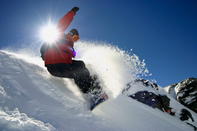Snowboarding History
Many board sports share a common history, with snowboarding borrowing in equal measures from sporting codes such as surfing, skateboarding and skiing.

Apparently children ‘surfed’ barrel staves sideways down snowy slopes as far back as the 1920s, but it was a good 50 years before snowboards as we know them today popped out of the proverbial woodwork.
The man responsible for this ‘woodwork’ is American Jake Burton Carpenter. He looked at Sherman Poppen’s ‘snurfer’ (or snow-surfer) and modified it by shaping light-weight wooden boards with rubber binding straps.
His home state of Vermont then went on to host the first snowboarding competitions during the late 70s and early 80s, and in 1988 snowboarding was finally ratified as an Olympic sport.
Dress Up for Mother Nature
Let’s face it: few South Africans get the opportunity to go wild in snowy climes. If you do get the chance to face winter head-on, make sure you dress up in hardcore outdoor gear able to withstand Mother Nature at her most extreme.
Functionality is key, and a good balance between breathability and moisture resistance is a priority. Invest in top-of-the-line footwear too, as your boots will be the connection between you and your board, and you may spend many hours hiking for pow if you head into backcountry mountains.
The board shape, size and design will depend very much on the terrain and conditions you expect to face in the great outdoors. Racing- and Alpine boards are long, rigid and quite narrow, while Freeride boards are even longer, but with a semi-directional design to allow for big turns. Freestyle boards are bi-directional and shorter, allowing the boarder to switch his stance at will.
Finally, an All-Mountain board is what you get when you combine a Freeride- and Freestyle Board, thus giving you an all-purpose board perfect for any backcountry assault.
Customise Your Look
Board construction is based on a wooden core which is then laminated with fibreglass, but it is not uncommon to see the contemporary manufacturers using carbon or Kevlar in some of their premium models.
Both the nose and tail of the board may be upturned - we mentioned switch-stance riding earlier on - while a steel edge enable the board to grab the surface once it tips through a specified angle. Like surfboards, your deck may end up being an extension of your personality, and most boarders spend ages customising their ‘look’.
Choose Your Style
Do not expect to become a pro boarder in an easy afternoon session or two. It is a complex and physical sport to master, and there are many apparent dangers associated with bombing a powder slope in avalanche country.
There are a number of disciplines to choose from, including Freeride, Freestyle, Alpine, Backcountry, Border-cross and Slalom, with many of the rules derived from skiing.
If you plan to hit the powder, put in some time on artificial slopes beforehand. Otherwise you could book a sandboarding lesson or two (or even skateboarding) in order to hone balance and muscle memory.
One-on-one lessons with a pro once you get to your destinations should get you up and carving within a couple of days, so don’t give up after your first dozen falls.